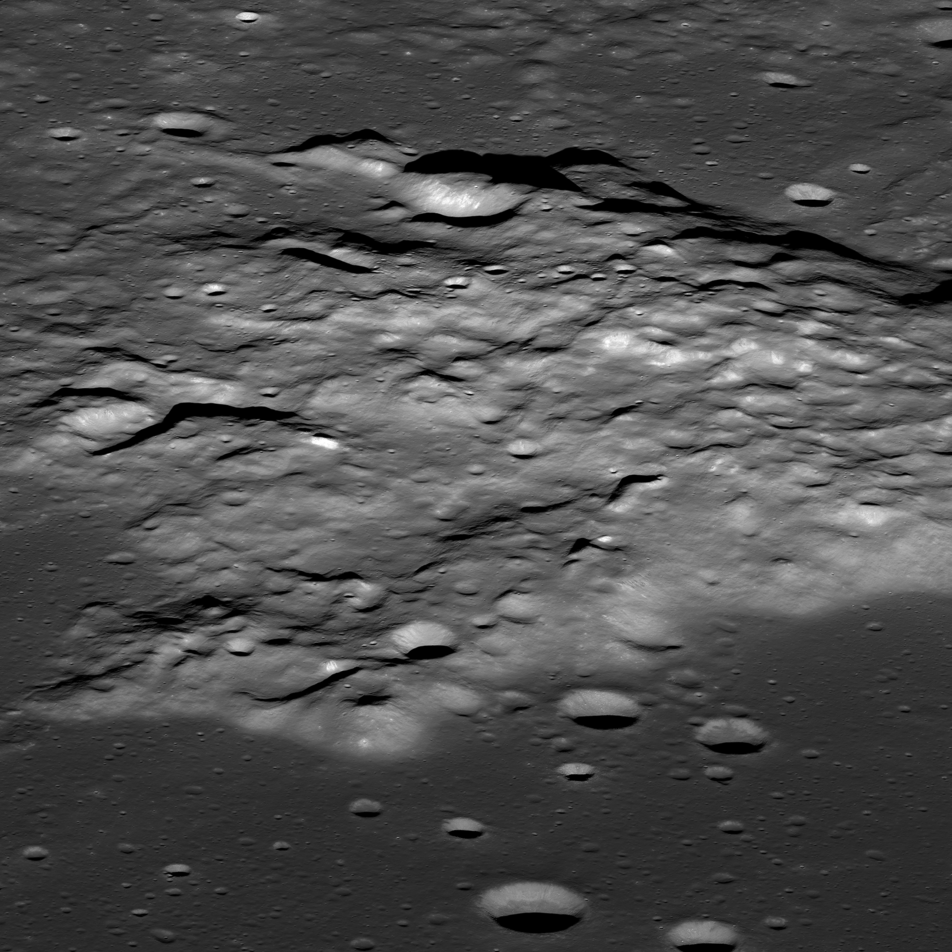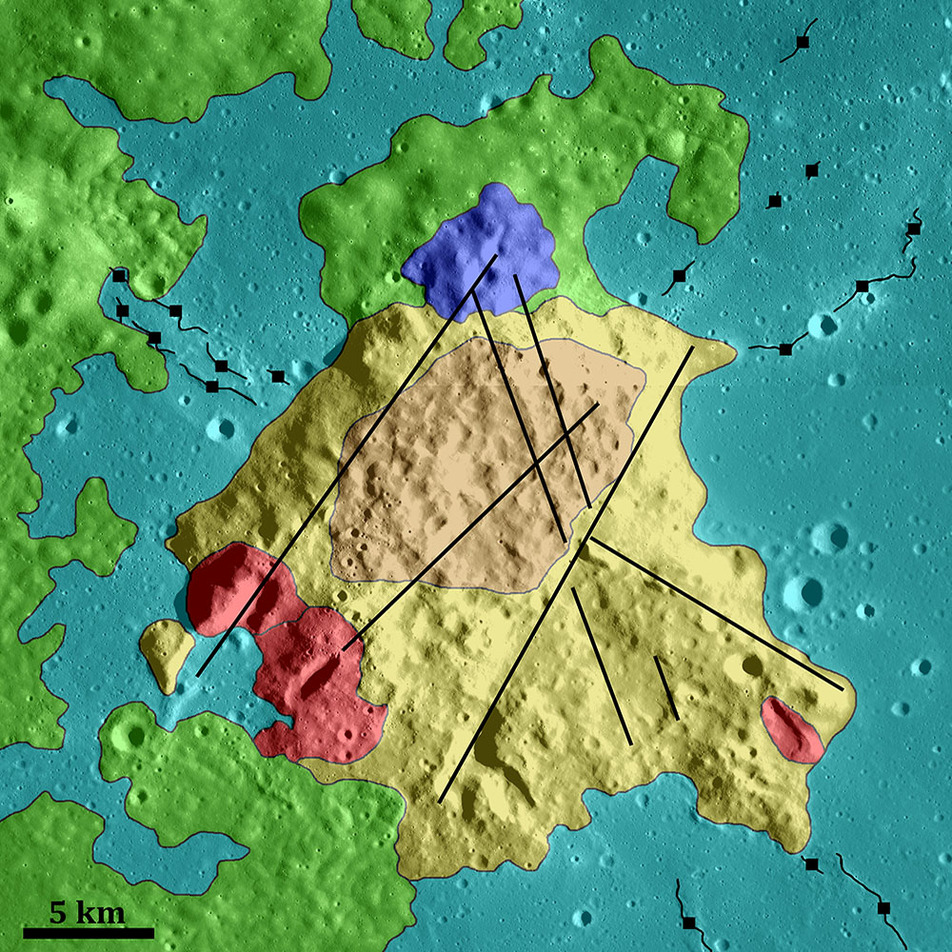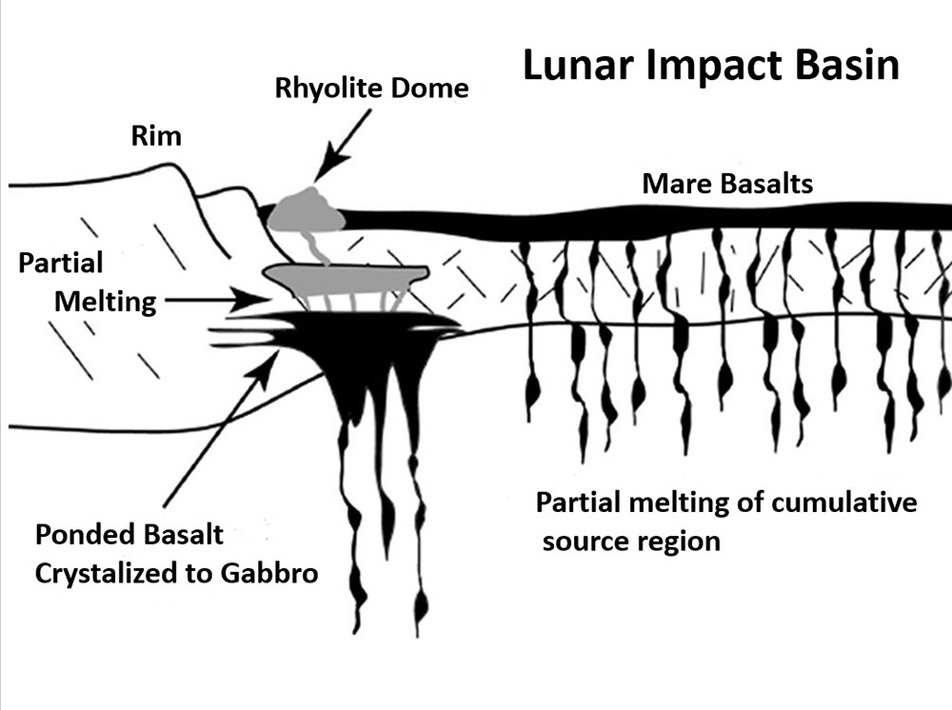
Two major rock types dominate the surface of the Moon, mare basalt and highlands anorthosite. You can easily spot these two types when you look up at the Moon each night: basalts are the dark areas, anorthosites are the brighter regions. However, remote sensing measurements show the presence of a few, scattered, relatively small volcanic centers composed of silica-rich rocks, such as rhyolite or dacite (the extrusive volcanic versions of granite or granodiorite). On the Earth, these types of rocks are usually formed through complex processes that involve remelting of rock and sediments at subduction zones. There are no subduction zones on the Moon, so the presence of these highly evolved rocks suggests unusual magmatic processes; lunar volcanism is far more complicated than early workers had thought. Unraveling the nature of these silicic rocks has major implications for understanding lunar thermal history and crustal evolution, as well as providing crucial information for understanding the early Moon.
Traditionally these small volcanic centers were called “red spots” because of their relatively high albedo and a strong absorption at shorter wavelengths (ultraviolet through blue-green wavelengths). They were suspected to be of unusual composition, but confirmation was lacking and the details were unknown. In a recent study photogeologic analysis of high-resolution images from LROC were combined with the full suite of available lunar remote sensing data to investigate the detailed geology of one of these red spots, Mons Hansteen (also known as Hansteen Alpha). Mons Hansteen is a relatively high-albedo, polygonal, arrowhead-shaped, low-relief dome that measures about 25 km on a side. The new analysis indicates that Mons Hansteen was formed as a two-layer mesa dotted by multiple volcanic vents and clusters of vents, with one satellite cinder cone located on its north flank. Model ages indicate that Mons Hansteen was produced in two major and distinct episodes. The first occurred at around 3.74 billion years ago, and the second about 250 million years later. The youngest of these eruptions appears to have coincided with the eruption of the surrounding mare basalt, around 3.50 billion years ago. The eruption of both silica-rich and basaltic lava at about the same time and in the same area suggests a genetic relationship and provides a test for current models of the origin of silica-rich magmas on the Moon.

There are two leading models for the origin of silica-rich magma on the Moon: fractional crystallization and crustal underplating. In the first, after a body of magma has nearly completely crystallized (>90%), some of the residual liquid can become extremely silicic. However, a key problem with this model is that fractional crystallization of even evolved magmas produces only small quantities of residual, silica-rich magma, perhaps not enough to produce the 25-km wide Mons Hansteen. The second model, crustal underplating, suggests that silica-rich volcanism occurs when large pools of basaltic magma rise from the mantle to the crust, and the heat from this magma causes the local crustal rocks to partially melt and erupt as rhyolites or dacites (see cartoon below). This mechanism is similar to one of the leading models proposed for production of some types of silicic rocks on Earth. The crustal underplating model predicts that at least some of the intruding magma should also erupt on the surface, producing new mare basalt deposits. Thus if this model is correct, silicic deposits (like Mons Hansteen) should have similar ages to nearby erupted mare basalts. While not a direct test that silicic eruptive materials on Mons Hansteen formed by partial melting of evolved crustal rock, the age correspondence is consistent with this idea. Similar detailed studies of other lunar silicic volcanic centers might reveal similar chronological relationships between silicic units and surrounding mare units.

This study was begun by the late and noted lunar scientist Dr. B. Ray Hawke, of the University of Hawaii, who had a love for all things lunar for his entire career, and a specific long-term interest in Mons Hansteen dating back many decades. B. Ray was instrumental in the targeting of many of the LROC data sets used here, and we sorely miss his encyclopedic knowledge of lunar geology and his willingness to share it with others.

For the full details on Mons Hansteen see the recent article published in the second LRO special issue of Icarus: Boyce, Joseph M., Giguere, Thomas A., Hawke, B. Ray, Mouginis-Mark, Peter J., Robinson, Mark S., Lawrence, Samuel J., Trang, David, and Clegg- Watkins, Ryan N. (2017) Hansteen Mons: An LROC geological perspective, Icarus, doi:10.1016/j.icarus.2016.08.013.
And scroll through the full-resolution version of the oblique view of Hansteen seen above:
Related LROC featured images on Mons Hansteen and sites of silicic volcanism:
New Views of the Gruithuisen Domes
The Color of the Lassell Massiff
Published by Brett Denevi on 10 April 2017